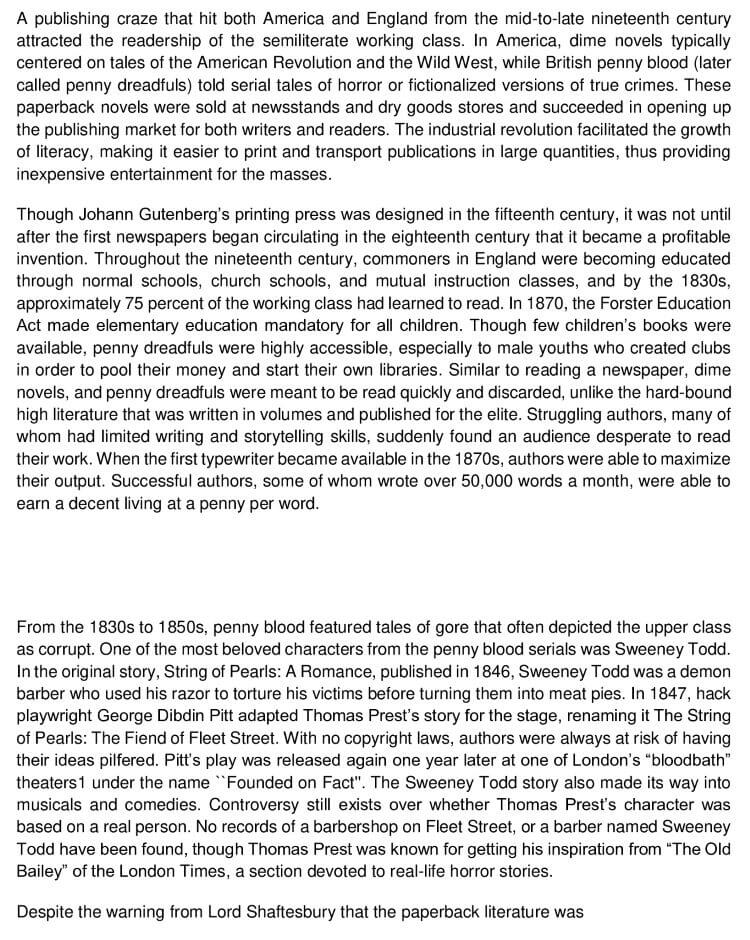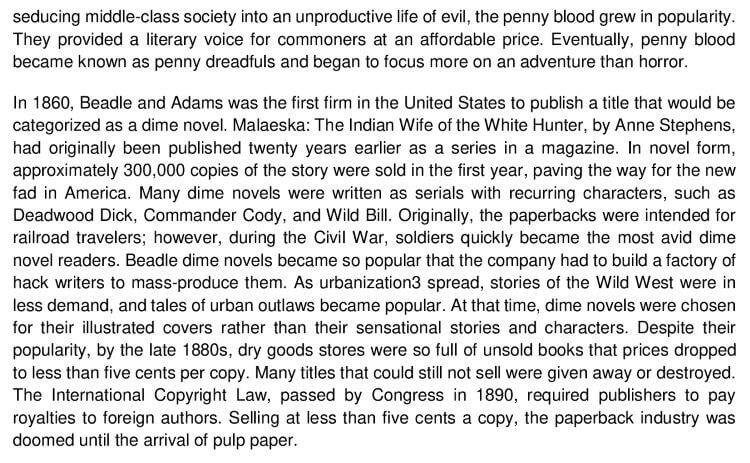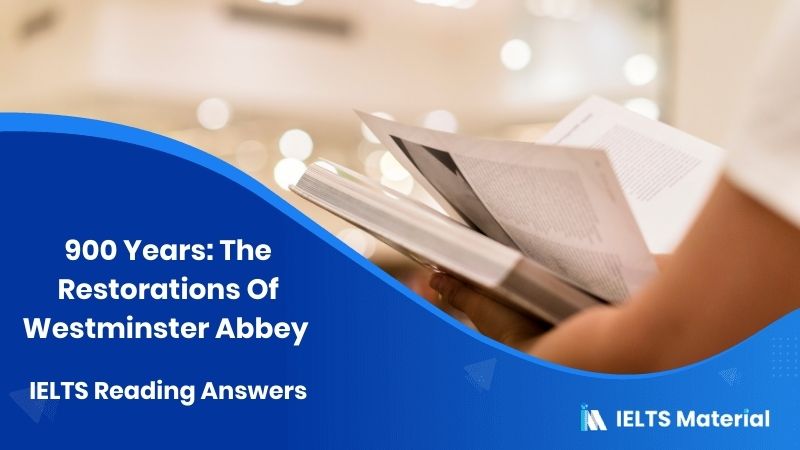Nineteenth Century Paperback Literature – IELTS Reading Answers
11 min read
Updated On
-
Copy link
Table of Contents

Limited-Time Offer : Access a FREE 10-Day IELTS Study Plan!
Various question types are asked in IELTS Academic Reading to test specific reading skills and some of them are given in Nineteenth Century Paperback Literature IELTS Reading Answers. These question types are:
- IELTS Reading Matching Features (Q. 14-19) & (Q. 20-22)
- IELTS Reading Yes/No/Not Given (Q. 23-27)
Ideally, IELTS test-takers should take around 20 minutes to solve a passage like ‘Nineteenth Century Paperback Literature’ in IELTS Academic Reading. Therefore, to master this skill, they need to take IELTS reading practice tests regularly. Let’s see how easy this passage is for you and if you’re able to make it in 20 minutes.
Reading Passage
Nineteenth-Century Paperback Literature


Questions 14—19
Which of the 14—19 characteristics below belongs to which type of literature?
On the lines answer sheet write:
if it is characteristic of penny blood
if it is characteristic of dime novels
if it is characteristic of both penny blood and dime novels
14 They were popular in America.
15 They were popular in Britain.
16 They showed members of the upper class as corrupt.
17 They were inexpensive.
18 They featured tales of the Wild West.
19 They were popular among members of the working class.
Questions 20-23
Match each year with the event that occurred during that year. Choose the correct
event, A-F, from the box below and write the correct letter on lines 20—23 on your
answer sheet.
There are more events than years, so you will not use them all.
20 1870
21 1846
22 1860
23 1890
Events
A The first dime novel was published in the US
B Lord Shaftesbury warned people about the dangers of penny blood
C if it is characteristic of both penny blood and dime novels
D A law was passed requiring children to attend school
E A law about copyrights was passed
F The first Sweeney Todd story was published
Questions 24—27
Do the following statements agree with the information in the reading passage? On lines 24—27 on your answer sheet write:
YES: if the statement agrees with the information
NO: if the statement contradicts the information
NOT GIVEN: If there is no information on this in the passage
24 The literacy rate in England rose in the nineteenth century.
25 Children’s books were popular in the nineteenth century.
26 Most people agree that Sweeney Todd was based on a real person.
27 Dime novels were popular among Civil War soldiers.
Answers of Nineteenth Century Paperback Literature Reading Answers With Location and Explanations
Make sure to check out the answers and detailed explanations of each question in the Nineteenth Century Paperback Literature passage and prepare to get a high IELTS Reading band score.
14 Answer: B
Question type: Matching Features
Answer location: Paragraph 1, line 2
Answer explanation: Paragraph 1, line 2 illustrates that in America, dime novels typically centered on tales of the American Revolution and the Wild West. These lines indicate that the dime novels were typically centered on the tales of the American Revolution and the wild west in America. Thus, Dime Novels were popular in America, so, the answer is B.
15 Answer: A
Question type: Matching Features
Answer location: Paragraph 1, line 3
Answer explanation: The 3rd line of paragraph A states that the British penny blood (later called penny dreadfuls) told serial tales of horror or fictionalized versions of true crimes. These lines indicate that penny blood was popular in Britain, and was later called penny dreadfuls. These novels reveal serial tales of horror or fictionalized versions of true crimes. Thus, the answer is A.
16 Answer: A
Question type: Matching Features
Answer location: Paragraph 3
Answer explanation: The introductory lines of paragraph 3 illustrate that the penny blood featured tales of gore that often depicted the upper class as corrupt from the 1830s to 1850s. We understand from these lines that penny blood featured the tales of gore which showed the upper class as corrupt from the 1830s to 1850s. Thus, the answer is A.
17 Answer: C
Question type: Matching Features
Answer location: Paragraph 1, line 5
Answer explanation: The 5th line of the first paragraph states that these paperback novels (penny blood and dime novels) were sold at newsstands and dry goods stores and succeeded in opening up the publishing market for both writers and readers. The industrial revolution facilitated the growth of literacy, making it easier to print and transport publications in large quantities, thus providing inexpensive entertainment for the masses. We can understand from these lines that the dime novels and penny blood were sold at newsstands and dry goods stores, and they also succeeded in establishing markets for writers and readers. This resulted in the growth of literacy, making it easier to print and transport publications in large quantities, and also providing inexpensive entertainment. Thus, the answer is C.
18 Answer: B
Question type: Matching Features
Answer location: Paragraph 1, line 2
Answer explanation: The 2nd line of the first paragraph states that in America, dime novels typically centered on tales of the American Revolution and the Wild West. These lines clearly indicate that the dime novel featured the tales of the Wild west apart from the American revolution. So, the answer is B.
19 Answer: C
Question type: Matching Features
Answer location: Paragraph 1
Answer explanation: The first paragraph reveals that the dime novels revolved around the tales of the Wild West and the American Revolution in America, whereas the penny blood was most popular in Britain. However, in the introductory lines of the first paragraph, it is stated that a publishing craze that hit both America and England from the mid-to-late nineteenth century attracted the readership of the semiliterate working class. We can understand from these lines that the publishing craze that hit both America and England in the mid-to-late 19th century was attracting the popular readers of the semi-illiterate working class. Thus, it’s clear that both Penny’s blood and dime were popular. So, the answer is C.
20 Answer: C
Question type: Matching Features
Answer location: Paragraph 2,line 5
Answer explanation: The 5th line of the 2nd paragraph illustrates that in 1870, the Forster Education Act made elementary education mandatory for all children. Though few children’s books were available, penny dreadfuls were highly accessible, especially to male youths who created clubs in order to pool their money and start their own libraries. Similar to reading a newspaper, dime novels, and penny dreadfuls were meant to be read quickly and discarded. We understand from these lines that when the act made it mandatory for the children to get themselves educated. Although only a few books were available, penny dreadfuls were highly accessible. However, just like reading a newspaper, dime novels and penny dreadfuls were meant to be discarded and read quickly. Thus, the answer is C.
21 Answer: F
Question type: Matching Features
Answer location: Paragraph 3, line 2
Answer explanation: The 2nd line of paragraph 3 illustrates that one of the most beloved characters from the penny blood serials was Sweeney Todd. In the original story, String of Pearls: A Romance, published in 1846, Sweeney Todd was a demon barber who used his razor to torture his victims before turning them into meat pies. These lines indicate that one of the most beloved characters from the penny blood serials was Sweeney Todd, and in the original story which was published in 1846, Todd was a demon barber who tortured his victims. Thus, the first Sweeney Todd story was published in 1846, so, the answer is F.
22 Answer: A
Question type: Matching Features
Answer location: Paragraph 6
Answer explanation: The initial lines of the 6th paragraph states that in 1860, Beadle and Adams was the first firm in the United States to publish a title that would be categorized as a dime novel. We can deduce from these lines that the firm in the US was Beadle and Adam who published a title categorizing it under dime novel in 1860. Thus, in 1860, the first dime novel was published in the US. So, the answer is A.
23 Answer: E
Question type: Matching Features
Answer location: Paragraph 5, last line
Answer explanation: The last line of paragraph 5 states that the International Copyright Law, passed by Congress in 1890, required publishers to pay royalties to foreign authors. These lines indicate that the first copyright law was passed in 1890. So, the answer is E.
24 Answer: Yes
Question type: Yes/No/ Not Given
Answer location: Paragraph 1
Answer explanation: We come to know from the first paragraph that the Penny blood and dime novels were popular in America and Britain. While Dime novels featured the wild west, Penny’s blood illustrated the tales of horror. In the 6th line, it is mentioned that the industrial revolution facilitated the growth of literacy, making it easier to print and transport publications in large quantities, thus providing inexpensive entertainment for the masses. We understand from these lines that the literacy rate in England witnessed growth in the 19th century. Therefore, the statement agrees with the facts, so, the answer is Yes.
25 Answer: No
Question type: Yes/No/ Not Given
Answer location: Paragraph 2, line 6
Answer explanation: The 6th line of the 2nd paragraph states, “though few children’s books were available, penny dreadfuls were highly accessible, especially to male youths who created clubs in order to pool their money and start their own libraries.” We can deduce from these lines that although children’s books were available, penny dreadfuls were highly accessible and popular amongst those male youngsters who created clubs to pool their money and set up their own library. Thus, the statement contradicts the information, so, the answer is No.
26 Answer: No
Question type: Yes/No/ Not Given
Answer location: Paragraph 3, line 2, and line 9
Answer explanation: The 2nd line of the 3rd paragraph reveals that one of the most beloved characters from the penny blood serials was Sweeney Todd. In the original story, String of Pearls: A Romance, published in 1846, Sweeney Todd was a demon barber who used his razor to torture his victims before turning them into meat pies. These lines depict that Sweeney Todd was published in 1846, in which Todd was a demon barber who tortured his victims by using his razor and turning them into meat pies. In the 9th line, it is mentioned that controversy still exists over whether Thomas Prest’s character was based on a real person. Thus, it’s unclear whether Sweeney Todd was based on a real person, so, the answer is No.
27 Answer: Yes
Question type: Yes/No/ Not Given
Answer location: Paragraph 5, line 6
Answer explanation: The 6th line of the 5th paragraph states that the paperbacks were originally intended for railroad travelers; however, during the Civil War, soldiers quickly became the most avid dime novel readers. Beadle dime novels became so popular that the company had to build a factory of hack writers to mass-produce them. We understand from these lines that soldiers were instantly adopted and became avid dime novel readers. In fact, the company had to construct a factory of hack writers to produce novels in mass numbers. Thus, the statement agrees with the information, so, the answer is Yes.
Tips to Solve the Question Types in Nineteenth Century Paperback Literature IELTS Reading Answers
Now that you have the answers and explanations for Nineteenth Century Paperback LiteratureReading Answers, let’s explore some IELTS exam preparation tips for answering the two question types.
Matching Features:
In this type of question, you will have to match a list of options with the relevant set of statements. Some tips to answer matching features questions and obtain a high band in the IELTS exam are given below:
- Read questions and underline or circle keywords. This will help you find out where you would have to read and find later. Also, focus on how often every detail or name is appearing in the passage.
- Scan the passage and look for information given in the features and questions.
- Skim through the areas that are surrounded by keywords and features in the passage.
- Don’t get confused in case the text has synonyms of the information that is originally present in the question.
- Keep in mind that answers will not be in an order as questions.
Yes/No/Not Given
Unlike True/False/Not Given IELTS Reading questions, ‘Yes/No/Not Given’ questions are based on opinions, views and beliefs of the author of the reading passage. A few statements will be provided to you, and it is up to you to determine whether they conform with the views/opinions of the writer by reading the text. You can use the following strategies to answer this question type:
- Always begin by reading the question and identifying the keywords. Before reading the material, have a look at your list of Yes, No, and Not Given questions.
- You need to scan the passage for synonyms or paraphrased words of the keywords. Once you have highlighted the keywords, swiftly read the text to look for paraphrases or synonyms.
- Matching highlighted words, or keywords in the questions with their synonyms in the text is the best way to figure out the answer. Once you find both sets of keywords, cross-check them to find the answer.
- Do NOT waste time if you are confused. If the facts match, the answer is YES, and in case it doesn’t match, it is NO. If you are unable to find the answer or unsure of it, mark it NOT GIVEN.
Check More IELTS Reading Answers
Also Check:
Practice IELTS Reading based on question types

Start Preparing for IELTS: Get Your 10-Day Study Plan Today!
Explore other Reading Topics

Janice Thompson

Janice Thompson
Recent Articles

Kasturika Samanta

Kasturika Samanta

Janice Thompson







Post your Comments